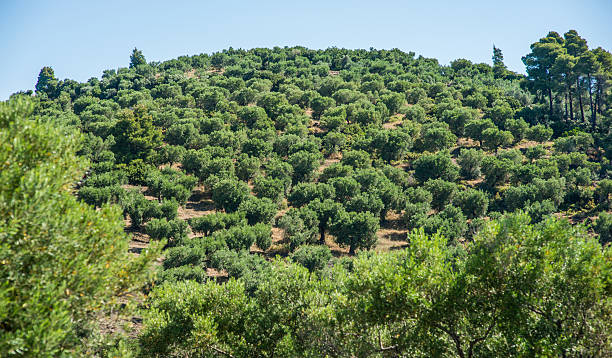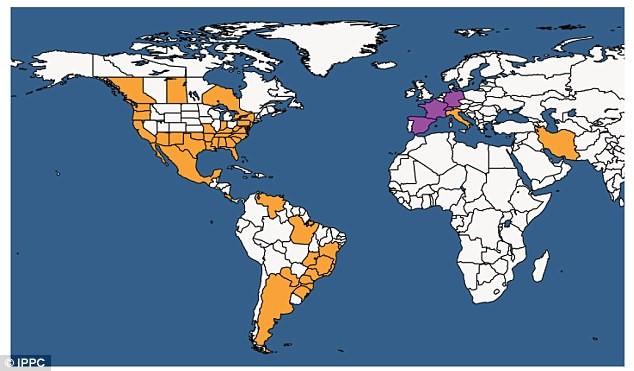5 - Environment and Agroecosystems
Figure
I: Olive trees in the field (Poplasen, 2016)
In this week’s weblog we
are looking at Spain’s climatic conditions and understand whether these are
optimal for the production of olives. But it also covers the irrigation method
and in which manner the crop is grown.
Figure II: Average Monthly Temperature and Rainfall in Spain from 1991-2015 (The World Bank Group, 1991 - 2015)
Spain has got a
predominantly warm Mediterranean climate, whereby it can be very dry in the
summer and temperatures in winter are balanced (Spain, N.D.) . As displayed in
figure II, average temperatures in the summer are high, while in other seasons
they are moderate. Additionally, in the same figure one can see the average
rainfall measured between 1991-2015, whereby in the months of June, July,
August and September there is little rainfall, and in the other months more rain
(The World Bank Group,
1991 - 2015) .
Finally, since Spain is the biggest olive producer, with 5,276.899 metric tons, we can easily concluded that the
climatic condition in the country are optimal in the production of olive tree (Sawe, 2017) (CABRERA, 2015) .
Irrigation
It is important to
know that olive trees are drought tolerant and therefore can survive on shallow
soils with little water supply (University of
California - UC Drought Management, N.D.) . Besides, for
centuries olive trees have been planted withoug irrigation in Mediterranean
climate condition (Fereres, N.D.) . Growing olives in
the traditional manner, which is in mountainous or hilly areas, there one does
not irrigate the tree but instead lies on rainfalls. While in modern process
irrigation and mechanisation is involved (European Commission,
Directorate-General for Agriculture and Rural Development , 2012) . In areas with an
annual rainfall higher than 600mm, olive production is maintained under rainfed
conditions, with soils that have got good water-holding capacity (Fereres,
N.D.) .
However, in case of extreme dryness one tend to use drip irrigation (ICARDA,
2014) .
Figure
III: Distribution of olvie groves in southern Spain (CABRERA, 2015)
Monoculture
Olive trees are
mainly grown in monoculture. In Jaén alone, a province in Spain (See: Figure III and Figure I ), 91% of
agricultural land within this province is occupied by olive trees, which has
resulted in a forming of huge swathe of green that extends across neighboring provinces (CABRERA, 2015) . By growing in this
monoculture the producers can concentrate on a single variety and work on a
single purpose, which are said to cut costs as far as possible. With the
results in fruits reaching optimum levels of ripeness at the same time.
References
CABRERA,
J. D.-M. (2015, September 15). THE OLIVE MONOCULTURE IN THE SOUTH OF
SPAIN. Retrieved October 3, 2017, from European Journal of Geography:
http://www.eurogeographyjournal.eu/articles/EJG020603CABRERA.pdf
European
Commission, Directorate-General for Agriculture and Rural Development .
(2012, July). Economic analysis of the olive sector. Retrieved October
2, 2017, from Europa:
https://ec.europa.eu/agriculture/olive-oil/economic-analysis_en.pdf
Fereres,
R. G. (N.D.). 4.1 Fruit tress and vinos. Retrieved October 2, 2017,
from Food and Agriculture Organization of the United Nations:
http://www.fao.org/docrep/016/i2800e/i2800e09.pdf
ICARDA.
(2014, August). Growing More Olives with Less Water. Retrieved October
2, 2017, from ICARDA:
https://www.icarda.org/sites/default/files/Olive%20irrigation_FINAL.pdf
Poplasen.
(2016). Olive trees grove by the sea. 616873196. iStockPhoto.
Retrieved October 2, 2017, from
http://www.istockphoto.com/ae/photo/olive-trees-grove-by-the-sea-gm616873196-107175761
Sawe,
B. E. (2017, April 25). Leading Olive Producing Countries. Retrieved
October 2, 2017, from World Atlas:
http://www.worldatlas.com/articles/leading-olive-producing-countries.html
Spain.
(N.D.). What is the weather like in Spain? Retrieved October 2, 2017,
from Spain:
http://www.spain.info/en/informacion-practica/consejos-viaje/consejos-practicos/clima/
The
World Bank Group. (1991 - 2015). Country Historical Climate. Retrieved
October 2, 2017, from The World Bank Group: http://sdwebx.worldbank.org/climateportal/index.cfm?page=country_historical_climate&ThisCCode=ESP
University
of California - UC Drought Management. (N.D.). Olives. Retrieved
October 2, 2017, from University of California - UC Drought Management:
http://ucmanagedrought.ucdavis.edu/Agriculture/Crop_Irrigation_Strategies/Olives/




Reacties
Een reactie posten